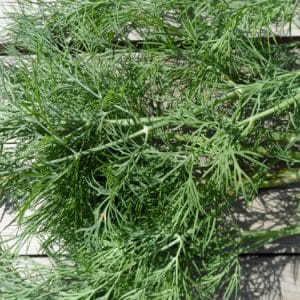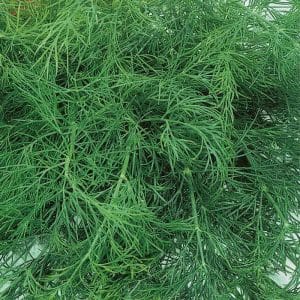Recommendations for caring for and growing Kibray dill: how to protect against pests and properly harvest
The Kibray dill variety is popular among Russian summer residents. It is valued for its unpretentiousness, resistance to disease and adverse weather conditions. The variety takes root in central Russia and even in colder regions.
In this article we will tell you how to effectively grow Kibray, what are the advantages and disadvantages of this variety.
Characteristics and description of the variety
Kibray is a late-ripening variety of dill; the first harvest can be harvested 40-45 days after sowing. The plant has a large, semi-raised rosette of greenery 30-40 cm high. The average weight of an adult bush is 20-30 g.
The leaf blades are heavily dissected, colored rich green with a slight yellowish tint and covered with a thin waxy coating. Dill It is characterized by increased juiciness, has a persistent, bright aroma and a delicate pungent taste.
Attention! The variety is intended for planting in open and closed ground. Since the crop is not afraid of cold and frost, it can be grown by gardeners from all regions of Russia.
Pros and cons of the variety
Kibray is valued by gardeners for a large number of advantages. These include:
- chemical composition rich in essential oils, vitamins and minerals;
- high productivity;
- the ability to grow green mass in unfavorable conditions;
- long term storage;
- large leaves;
- excellent taste;
- versatility of cultivation and use;
- resistance to pests and diseases;
- does not lose its beneficial properties and taste after freezing and drying.
Kibray dill is actively used for preparing marinades, vitamin salads and seasonings. It is added to various dishes as a spice and consumed fresh.
The disadvantages of the variety include:
- long ripening period;
- stagnation of moisture in the root zone can lead to rotting of the stems;
- the seeds are covered with a layer of essential oils, which reduces their germination if pre-planting preparation is not carried out.
Productivity
Thanks to its high resistance to unfavorable climatic conditions, pests and diseases, Kibray dill produces a plentiful and high-quality harvest. From a square meter you can collect 1.5-3 kg of herbs and 2.5-6 kg of raw materials for preparing spices. The harvest is perfectly stored, remains juicy for a long time and retains an attractive presentation.
Reference! The variety is often used for conveyor production of greens: little time passes from the appearance of the first shoots to stem formation, so you can forget about additional “reseedings”.
How to grow
The variety does not require special care - even novice summer residents can cope with its cultivation. Kibray is a cold-resistant crop, so its seeds can germinate at a soil temperature of +3°C and can easily survive frosts down to -4°C, but for normal development the plant needs +10-15°C.
They are sown in mid-spring, after the snow has melted from the area. To obtain an early harvest, Kibray dill is planted in early April, weather permitting. After that, additional seeding is done every two weeks to ensure constant production of fresh grass.
Attention! In the northern regions, sowing is recommended to be done in late April - early May.
Sowing seeds and growing seedlings

They begin preparing the beds in the fall; to do this, select an area with good lighting or light shading and dig it to a depth of 10 cm with a composition to improve the quality of the soil.
For one square meter of soil add:
- superphosphate - 70 g;
- ammonium nitrate - 90 g;
- potassium salt - 60 g.
In the spring, the chosen place is dug up again, cleared of weeds and a bed is formed. Planting is carried out according to the scheme given in the table.
| Depth of seed placement in the soil | 1-2 cm | |
| Furrow width | 5 cm | |
| Distance between | in rows | 30 cm |
| plants | 15 cm | |
The germination of seeds is negatively affected by the film of essential oils covering the planting material, so experienced gardeners recommend removing it before sowing.
For this:
- Place the seeds in a gauze bag and immerse them in hot (about 50°C) water for three days.
- Replace the cooled liquid with fresh one 3-5 times a day.
- Remove the seeds from the water and wrap them in a damp cloth.
- In such conditions, keep them for four days at a temperature of 20°C.
- Dry the planting material before sowing.
Important! These procedures will not only wash off the oil film, but will also disinfect the seeds, increase their immunity and accelerate germination.
Sow in open ground as follows:
- Furrows 5 cm wide and 2 cm deep are formed in the bed. The distance between them should be at least 30 cm.
- The furrows are watered abundantly with warm, settled water.
- They are planted, after which the seeds are covered with light, nutritious soil.
- After the emergence of seedlings, excess bushes are removed to prevent strong thickening in the garden bed.
For those who want to get the harvest early, you can first grow seedlings at home, for example, in E6 cassettes, and then transplant them into open ground. They do it like this:
- Loose garden soil is mixed with neutral soil for indoor flowers in a 1:1 ratio.
- The bottom of wooden boxes or plastic containers is filled with drainage material. To do this, use expanded clay, broken brick, crushed foam, clay shards, coarse sand or small pebbles.

- Then the containers are filled with a mixture of soils and grooves 1 cm deep are made in it.
- They are spilled with plenty of water, after which they are filled with seeds, observing the seeding rate of 0.3 g per sq. dm.
- The plantings are covered with a thin layer of dry soil or a mixture of peat and humus.
- The boxes are covered with cling film or a piece of glass and placed in a dark place with a temperature of +20°C for one week.
- Then they are moved to a windowsill with good, but not too bright lighting and periodically watered with a spray bottle so as not to wash out or damage the small sprouts.
- After 35 days, the bushes are transplanted to a permanent place, based on the planting scheme indicated in the table.
Attention! When the temperature drops sharply, young plantings in open ground are covered with film. It will be removed when the weather becomes warm enough again.
Watering
Dill loves moisture very much, so it is watered often and abundantly. Although Kibray is considered a drought-resistant variety, to obtain juicy and lush greenery, 5-6 liters of water per square meter is required. m 2-3 times a week.
Once every 10-14 days, it is recommended to water the dill with nettle infusion. It will nourish the plant with useful substances, increase resistance to diseases and unfavorable growing conditions.
To prepare the product:
- Take nettles without seeds, chop them and fill half a bucket.
- Fill the container with boiling water to the brim and close the lid.
- Leave for 14 days, remembering to stir the product once a day.
- Strain and add a glass of infusion to 5 liters of water for irrigation.
Feeding
During the season, it is enough to feed Kibrai twice: the first - 10 days after the emergence of several true leaves, and the second - after another 2-3 weeks.
To do this, use mineral fertilizer prepared according to the following recipe:
- urea - 25 g;
- potassium salt - 20 g;
- water 10 l.
This amount of product is enough for 4 square meters. m landings. After fertilizing, the bed is watered generously with warm water.
Important! Do not use nitrogen fertilizers, as dill tends to accumulate nitrates in the foliage. Also, avoid adding organic compounds during periods of drought and heat, as this will lead to burns and plant death.
Soil care
Periodically remove weeds from the garden beds and loosen the row spaces. It is especially important to loosen the soil after rains and waterings, as soon as it dries out. This is necessary to remove the earthen crust, as it prevents air and water from penetrating to the root system of the bushes.
Prevention of diseases and pests

The Kibray variety is resistant to disease and is not afraid pests, but experienced gardeners advise not to forget about prevention, especially if dill grows next to other garden crops.
| Methods | Measures | |
| Agrotechnical |
|
|
| Folk | From diseases |
|
| From insects |
|
|
| Store | For spraying against diseases |
|
| From insects | Sprinkle the beds with tobacco dust - 1 tbsp. per sq. m. | |
Attention! Avoid using chemical remedies, as they are present in dill leaves and can be harmful to health.
Reviews from gardeners
Many positive reviews about the Kibray dill variety have been published on the forums:
Elena, Almetyevsk: “An excellent variety, produces lush and juicy greens. If you wash the seeds from the oil layer, their germination rate will be at least 95%. Kibray does not go into umbrellas for a long time; they appear closer to autumn.”
Arkady, Irkutsk: “Kibray takes root well in our region and is not afraid of frost. Dill grows fragrant and tasty. The leaves are not rough, suitable for drying, freezing, and pickling.”
Conclusion
Kibray dill is excellent for growing in central Russia, as well as in colder regions. Gardeners choose it because of its increased cold resistance, ease of care, as well as a rich and high-quality harvest of greenery. This plant takes root well in areas with different soil compositions and is suitable for cultivation by novice gardeners.